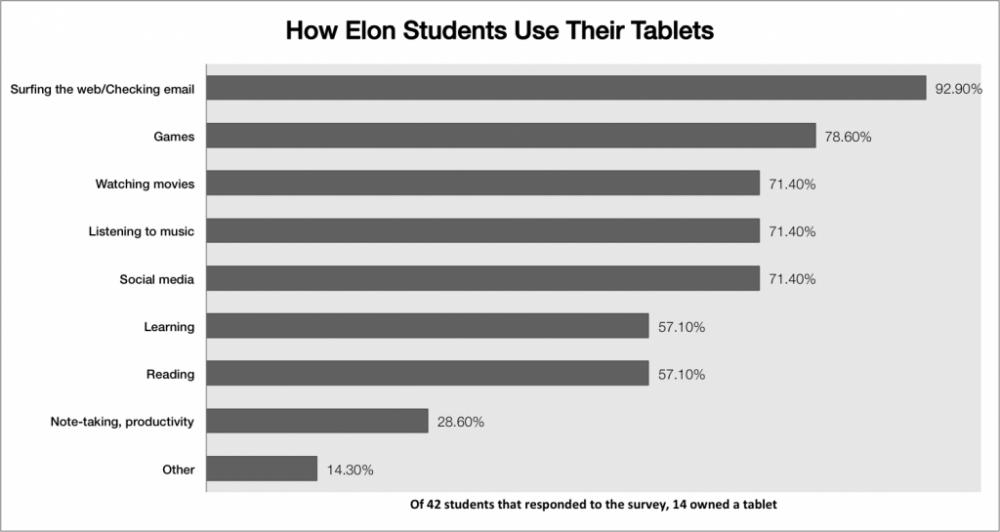While the public meets Apple’s product announcements with a huge amount of excitement, few students at Elon University seem to care about the new iPad’s launch last Friday.
Tablets such as the iPad allow for more possibilities in schools: e-textbooks, productivity and note-taking, interactive learning apps.
“What I like about them is the instant on and the battery life,” said Scott Hildebrand, assistant director of Teaching and Learning Technologies. “I take my tablet when I’m going to a meeting or traveling. Most everything I use syncs with the cloud and it’s all right here.”
Hildebrand is behind several initiatives to incorporate tablets into teaching and learning, including a monthly tablet user group for faculty members, short and long-term tablet rental programs and working to bring tablets into the classroom.
“We noticed more and more tablets showing up on campus and we were just trying to get an idea on how they were being used,” Hildebrand said. “It’s really great having users show up and say ‘These are the apps that I found this week, here’s how they’re helping me.’”
But when it comes to tablet usage on campus, it is far greater among faculty members than students.
“We haven’t bridged the student divide yet,” Hildebrand said of the user group, “We haven’t seen a lot of them being used by students yet.”
A non-scientific online survey of 43 random Elon students showed that just 32.6 percent of respondents did own a tablet, the overwhelming majority of those being the iPad 2.
“I would expect there to be more than there have been so far,” senior Casey Claude said, who got an iPad 2 for Christmas. “But iPads are new still, but as they continue to get cheaper, I think we will.”
Joel Hollingsworth, professor of computing sciences, teaches a Mobile Computing course, in which his students get to build applications for smartphones and tablets. Hollingsworth is not in the user group, but has also seen them used infrequently by students in the classroom.
“Why don’t students, instead of carrying around a backpack full of books to class, carry around an iPad or something and pull that out?” asked Hollingsworth.
While the tablet provides applications useful for students, materials students require are often not available.
Hollingsworth said he believes the slow adoption of tablets by students is because of textbook publishers being slower to produce their content in digital format.
“It hasn’t caught on as fast as we thought it would, mainly because students don’t have the devices,” said Randy Piland, faculty fellow for technology, in a recent interview for The Swing.
Apple releases the iPad HD March 16. The new device sports a better camera, 4G-connectivity and a new screen.
Hollingsworth said he is most interested in the new iPad’s better screen resolution, which, at 2048x1536 pixels, is higher than most high-definition TVs.
“It’s so high, which means the types of images you’re going to be able to put out on that are going to be amazing,” Hollingsworth said.
But even with the introduction of a new iPad, students don’t seem sold on tablets. Not one survey respondent said they would definitely purchase the new iPad.
“Most students are coming with their laptops, coming with their phones, and they don’t really need that third device in between,” Hildebrand said. “Someone made a comment earlier this week that their grandmother adopted the iPad sooner than they had.”
Although Claude uses her tablet to take notes in class, she said she is still surrounded by the laptops of other students.
Even with evolving tablet technology there is still a need for the personal computer, according to Hildebrand.
Ninety-five percent of the survey respondents agree if students could pick just one device to have with them at college, they would still pick the computer over the tablet.
While there may be a day when tablets replace computers, it doesn’t seem to be in the immediate future.


